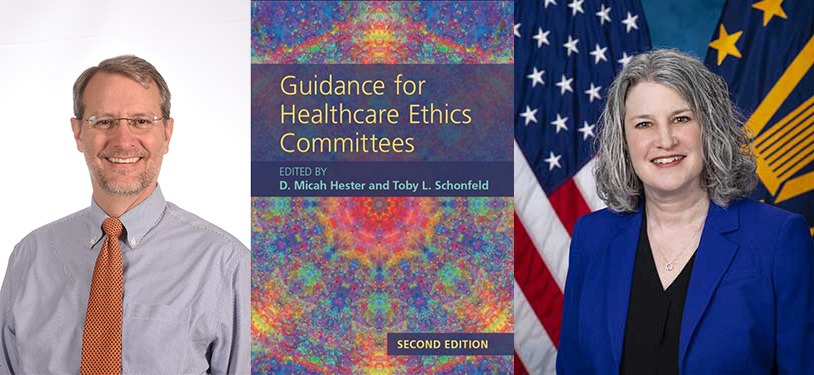Authors Update ‘Healthcare Ethics’ with Second Edition
| In early 2020 just as D. Micah Hester, Ph.D., and his co-editor Toby Schonfeld, Ph.D., hoped to finalize the text of the second edition of Guidance for Healthcare Ethics Committees, the COVID-19 pandemic spread across the United States and the world.
Hester is the chair of the Department of Medical Humanities & Bioethics in the UAMS College of Medicine, and Schonfeld is the executive director of the National Center for Ethics in Health Care, U.S. Department of Veterans Affairs.
The public health crisis that COVID-19 precipitated not only delayed getting the newly updated book to the publisher, it also shaped and influenced its content.
Even without the pandemic, changes in health care and its expansion into new areas of medical science had changed thinking about ethics committees since the publication of the first edition in 2012, Hester said.
“During that timeframe, we have experienced the pandemic and have had to think now about the possibility of having to allocate vital, scarce resources, for example,” he said. “The pandemic drove that situation home. How does this healthcare picture look differently, if our resources get scarce for any reason?”
Another question that factors into contemporary thinking about bioethics is how the mission of a healthcare institution relates to specific, individual patient care. The pandemic added great urgency to the decisions that were once left to an ethics committee to make and pushed them up to hospital and clinic administrations to consider for quicker answers.
Hester said the third factor driving the need for a new edition is a newly accredited certification in clinical ethics consultation. While certification is currently not required to work in the field, he noted that it could become one in the next several years. Hester also mention, “It is worth noting that the first edition of this text is one of about a dozen resources specifically cited by the certification commission as fundamental to studying for the exam.”
While the new edition has grown from 196 to 271 pages, “Guidance” is still not as large and intimidating as other volumes on the subject of bioethics.
The chapters are purposely short, built around medical cases and ending with a set of questions meant to prompt thinking about and discussion of ethical questions.
“We didn’t want a 500-page tome,” Hester said. “We didn’t want someone to think ‘This is too big’ even though you can use it a chapter at a time. The feel of it can put people off.”
Ten chapters were completely new from the first to the second edition while multiple chapters in the first were condensed and combined to keep the writing concise.
Targeted to a national audience, there is no UAMS-specific content However, Hester said many of the university’s healthcare professionals will find the material relevant.
“The health disparities chapter provides a useful way to think through issues important to Arkansas, a rural state with a clear chasm of health disparities ,” he said. “We mention health disparities a lot at UAMS, but not everyone has thought through the issues carefully to consider how they play out.”
Other chapters cover a variety of topics and will help committees answer questions about informed consent, surrogate decision-making, potentially inappropriate treatment and medical futility and psychiatric ethics among many others.
Cambridge University Press published the book in May, ten years after the first edition.
“So far the response has been positive,” Hester said. “We have heard people like the new additions. There is very little education material available that specifically targets ethics committees. If you’re a nurse or physician or social worker who joins a bioethics committee, then there is very little out there for you to educate yourself. I’m very happy with the finished product.”
